In-depth Analysis: Ethical and Legal Dimensions of Patient Treatment
VerifiedAdded on 2023/06/05
|6
|1610
|217
Case Study
AI Summary
This case study presents the scenario of Ms. Christine Jones, a 34-year-old patient admitted to the emergency department with severe injuries following a motor vehicle accident, complicated by the discovery of her pregnancy and the loss of her partner. The case highlights ethical and legal challenges in her treatment, specifically concerning the application of the Guardianship and Administration Act 1990 (revised 2005) and the Advanced Healthcare Planning Legislation of WA Government (2006). The ethical dilemmas include informing the patient about her partner's death and navigating her refusal of surgery due to concerns for her unborn child's safety, which is protected under the WA government's legislation allowing patients to refuse non-urgent medical treatment. The case underscores the importance of communication strategies and involving the patient's family in decision-making while respecting the patient's autonomy and legal rights. The author reflects on their experience during a shift, emphasizing the difficulty of convincing Ms. Jones to undergo surgery and suggesting a group discussion with her mother to address her concerns. The solution refers to multiple research articles to support the arguments. Desklib provides a platform to explore similar case studies and solved assignments.
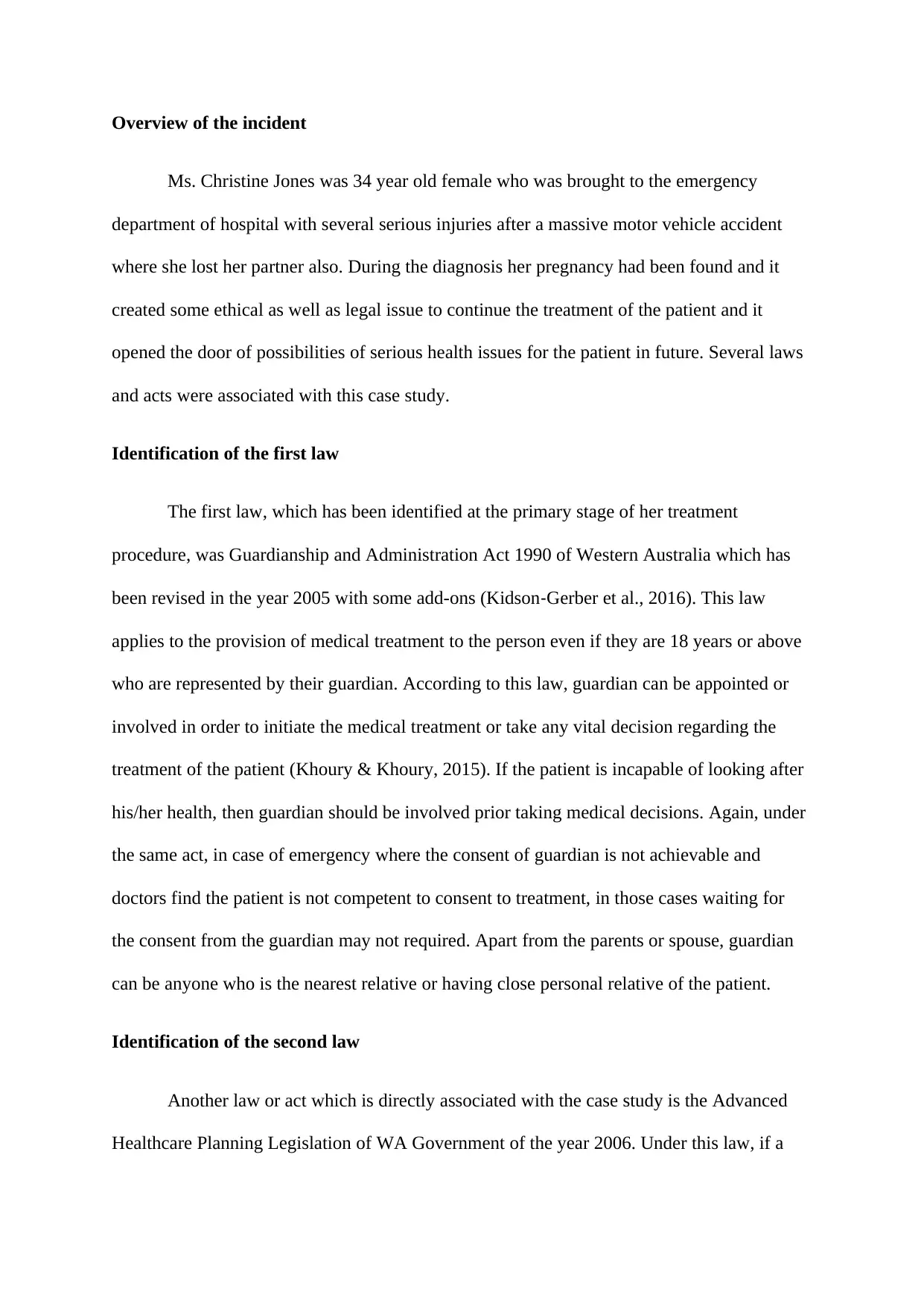
Overview of the incident
Ms. Christine Jones was 34 year old female who was brought to the emergency
department of hospital with several serious injuries after a massive motor vehicle accident
where she lost her partner also. During the diagnosis her pregnancy had been found and it
created some ethical as well as legal issue to continue the treatment of the patient and it
opened the door of possibilities of serious health issues for the patient in future. Several laws
and acts were associated with this case study.
Identification of the first law
The first law, which has been identified at the primary stage of her treatment
procedure, was Guardianship and Administration Act 1990 of Western Australia which has
been revised in the year 2005 with some add-ons (Kidson‐Gerber et al., 2016). This law
applies to the provision of medical treatment to the person even if they are 18 years or above
who are represented by their guardian. According to this law, guardian can be appointed or
involved in order to initiate the medical treatment or take any vital decision regarding the
treatment of the patient (Khoury & Khoury, 2015). If the patient is incapable of looking after
his/her health, then guardian should be involved prior taking medical decisions. Again, under
the same act, in case of emergency where the consent of guardian is not achievable and
doctors find the patient is not competent to consent to treatment, in those cases waiting for
the consent from the guardian may not required. Apart from the parents or spouse, guardian
can be anyone who is the nearest relative or having close personal relative of the patient.
Identification of the second law
Another law or act which is directly associated with the case study is the Advanced
Healthcare Planning Legislation of WA Government of the year 2006. Under this law, if a
Ms. Christine Jones was 34 year old female who was brought to the emergency
department of hospital with several serious injuries after a massive motor vehicle accident
where she lost her partner also. During the diagnosis her pregnancy had been found and it
created some ethical as well as legal issue to continue the treatment of the patient and it
opened the door of possibilities of serious health issues for the patient in future. Several laws
and acts were associated with this case study.
Identification of the first law
The first law, which has been identified at the primary stage of her treatment
procedure, was Guardianship and Administration Act 1990 of Western Australia which has
been revised in the year 2005 with some add-ons (Kidson‐Gerber et al., 2016). This law
applies to the provision of medical treatment to the person even if they are 18 years or above
who are represented by their guardian. According to this law, guardian can be appointed or
involved in order to initiate the medical treatment or take any vital decision regarding the
treatment of the patient (Khoury & Khoury, 2015). If the patient is incapable of looking after
his/her health, then guardian should be involved prior taking medical decisions. Again, under
the same act, in case of emergency where the consent of guardian is not achievable and
doctors find the patient is not competent to consent to treatment, in those cases waiting for
the consent from the guardian may not required. Apart from the parents or spouse, guardian
can be anyone who is the nearest relative or having close personal relative of the patient.
Identification of the second law
Another law or act which is directly associated with the case study is the Advanced
Healthcare Planning Legislation of WA Government of the year 2006. Under this law, if a
Paraphrase This Document
Need a fresh take? Get an instant paraphrase of this document with our AI Paraphraser
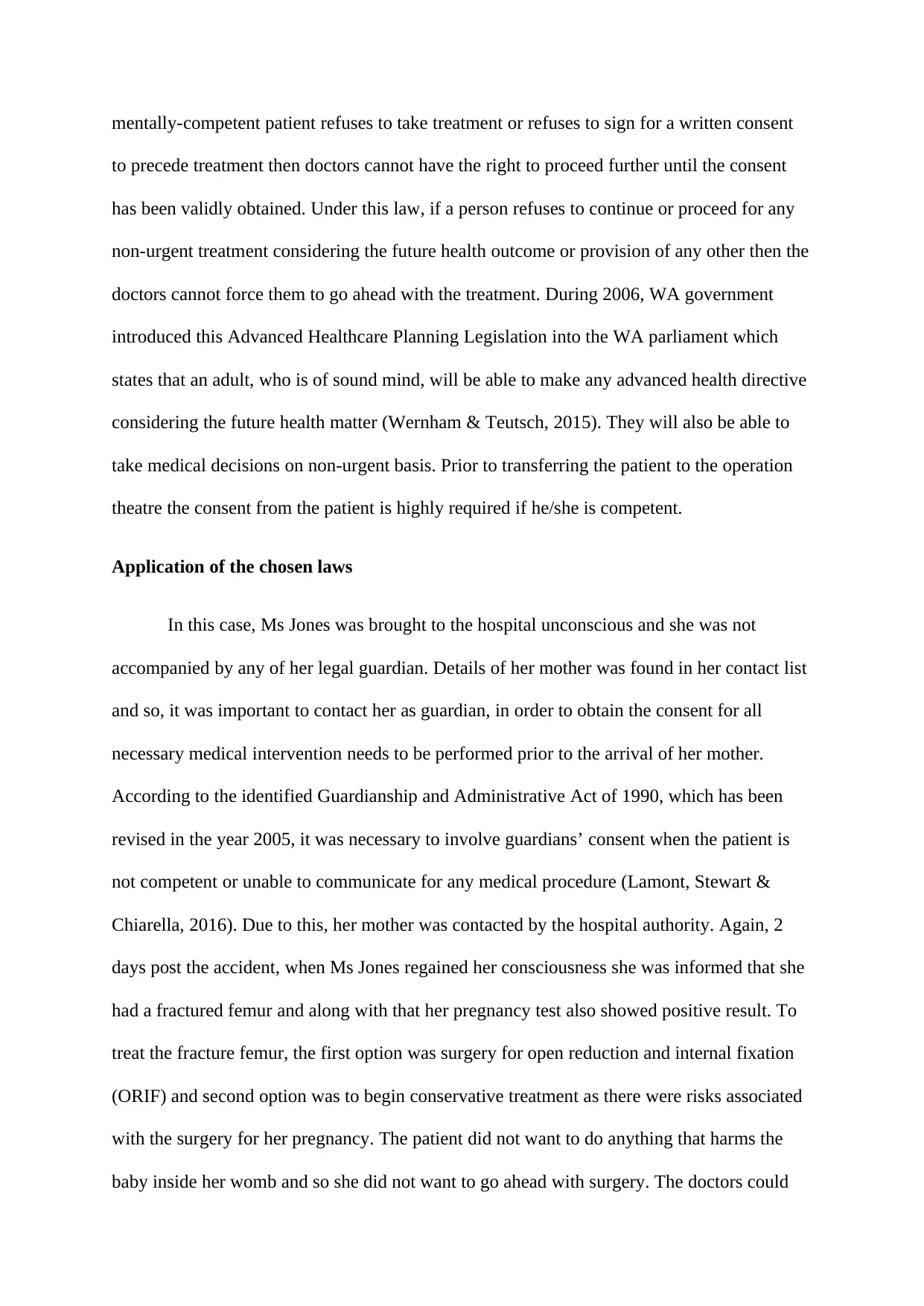
mentally-competent patient refuses to take treatment or refuses to sign for a written consent
to precede treatment then doctors cannot have the right to proceed further until the consent
has been validly obtained. Under this law, if a person refuses to continue or proceed for any
non-urgent treatment considering the future health outcome or provision of any other then the
doctors cannot force them to go ahead with the treatment. During 2006, WA government
introduced this Advanced Healthcare Planning Legislation into the WA parliament which
states that an adult, who is of sound mind, will be able to make any advanced health directive
considering the future health matter (Wernham & Teutsch, 2015). They will also be able to
take medical decisions on non-urgent basis. Prior to transferring the patient to the operation
theatre the consent from the patient is highly required if he/she is competent.
Application of the chosen laws
In this case, Ms Jones was brought to the hospital unconscious and she was not
accompanied by any of her legal guardian. Details of her mother was found in her contact list
and so, it was important to contact her as guardian, in order to obtain the consent for all
necessary medical intervention needs to be performed prior to the arrival of her mother.
According to the identified Guardianship and Administrative Act of 1990, which has been
revised in the year 2005, it was necessary to involve guardians’ consent when the patient is
not competent or unable to communicate for any medical procedure (Lamont, Stewart &
Chiarella, 2016). Due to this, her mother was contacted by the hospital authority. Again, 2
days post the accident, when Ms Jones regained her consciousness she was informed that she
had a fractured femur and along with that her pregnancy test also showed positive result. To
treat the fracture femur, the first option was surgery for open reduction and internal fixation
(ORIF) and second option was to begin conservative treatment as there were risks associated
with the surgery for her pregnancy. The patient did not want to do anything that harms the
baby inside her womb and so she did not want to go ahead with surgery. The doctors could
to precede treatment then doctors cannot have the right to proceed further until the consent
has been validly obtained. Under this law, if a person refuses to continue or proceed for any
non-urgent treatment considering the future health outcome or provision of any other then the
doctors cannot force them to go ahead with the treatment. During 2006, WA government
introduced this Advanced Healthcare Planning Legislation into the WA parliament which
states that an adult, who is of sound mind, will be able to make any advanced health directive
considering the future health matter (Wernham & Teutsch, 2015). They will also be able to
take medical decisions on non-urgent basis. Prior to transferring the patient to the operation
theatre the consent from the patient is highly required if he/she is competent.
Application of the chosen laws
In this case, Ms Jones was brought to the hospital unconscious and she was not
accompanied by any of her legal guardian. Details of her mother was found in her contact list
and so, it was important to contact her as guardian, in order to obtain the consent for all
necessary medical intervention needs to be performed prior to the arrival of her mother.
According to the identified Guardianship and Administrative Act of 1990, which has been
revised in the year 2005, it was necessary to involve guardians’ consent when the patient is
not competent or unable to communicate for any medical procedure (Lamont, Stewart &
Chiarella, 2016). Due to this, her mother was contacted by the hospital authority. Again, 2
days post the accident, when Ms Jones regained her consciousness she was informed that she
had a fractured femur and along with that her pregnancy test also showed positive result. To
treat the fracture femur, the first option was surgery for open reduction and internal fixation
(ORIF) and second option was to begin conservative treatment as there were risks associated
with the surgery for her pregnancy. The patient did not want to do anything that harms the
baby inside her womb and so she did not want to go ahead with surgery. The doctors could
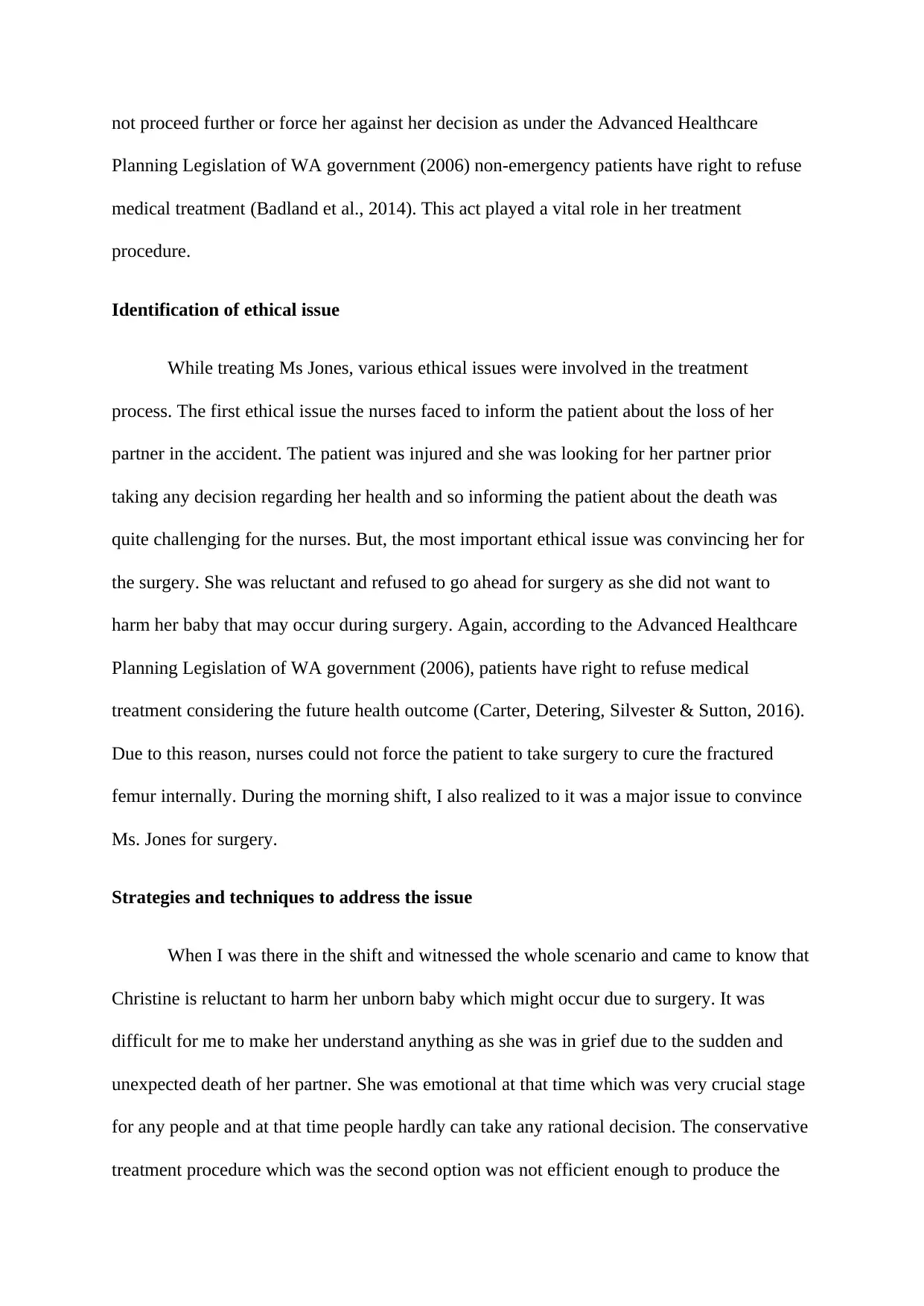
not proceed further or force her against her decision as under the Advanced Healthcare
Planning Legislation of WA government (2006) non-emergency patients have right to refuse
medical treatment (Badland et al., 2014). This act played a vital role in her treatment
procedure.
Identification of ethical issue
While treating Ms Jones, various ethical issues were involved in the treatment
process. The first ethical issue the nurses faced to inform the patient about the loss of her
partner in the accident. The patient was injured and she was looking for her partner prior
taking any decision regarding her health and so informing the patient about the death was
quite challenging for the nurses. But, the most important ethical issue was convincing her for
the surgery. She was reluctant and refused to go ahead for surgery as she did not want to
harm her baby that may occur during surgery. Again, according to the Advanced Healthcare
Planning Legislation of WA government (2006), patients have right to refuse medical
treatment considering the future health outcome (Carter, Detering, Silvester & Sutton, 2016).
Due to this reason, nurses could not force the patient to take surgery to cure the fractured
femur internally. During the morning shift, I also realized to it was a major issue to convince
Ms. Jones for surgery.
Strategies and techniques to address the issue
When I was there in the shift and witnessed the whole scenario and came to know that
Christine is reluctant to harm her unborn baby which might occur due to surgery. It was
difficult for me to make her understand anything as she was in grief due to the sudden and
unexpected death of her partner. She was emotional at that time which was very crucial stage
for any people and at that time people hardly can take any rational decision. The conservative
treatment procedure which was the second option was not efficient enough to produce the
Planning Legislation of WA government (2006) non-emergency patients have right to refuse
medical treatment (Badland et al., 2014). This act played a vital role in her treatment
procedure.
Identification of ethical issue
While treating Ms Jones, various ethical issues were involved in the treatment
process. The first ethical issue the nurses faced to inform the patient about the loss of her
partner in the accident. The patient was injured and she was looking for her partner prior
taking any decision regarding her health and so informing the patient about the death was
quite challenging for the nurses. But, the most important ethical issue was convincing her for
the surgery. She was reluctant and refused to go ahead for surgery as she did not want to
harm her baby that may occur during surgery. Again, according to the Advanced Healthcare
Planning Legislation of WA government (2006), patients have right to refuse medical
treatment considering the future health outcome (Carter, Detering, Silvester & Sutton, 2016).
Due to this reason, nurses could not force the patient to take surgery to cure the fractured
femur internally. During the morning shift, I also realized to it was a major issue to convince
Ms. Jones for surgery.
Strategies and techniques to address the issue
When I was there in the shift and witnessed the whole scenario and came to know that
Christine is reluctant to harm her unborn baby which might occur due to surgery. It was
difficult for me to make her understand anything as she was in grief due to the sudden and
unexpected death of her partner. She was emotional at that time which was very crucial stage
for any people and at that time people hardly can take any rational decision. The conservative
treatment procedure which was the second option was not efficient enough to produce the
⊘ This is a preview!⊘
Do you want full access?
Subscribe today to unlock all pages.

Trusted by 1+ million students worldwide
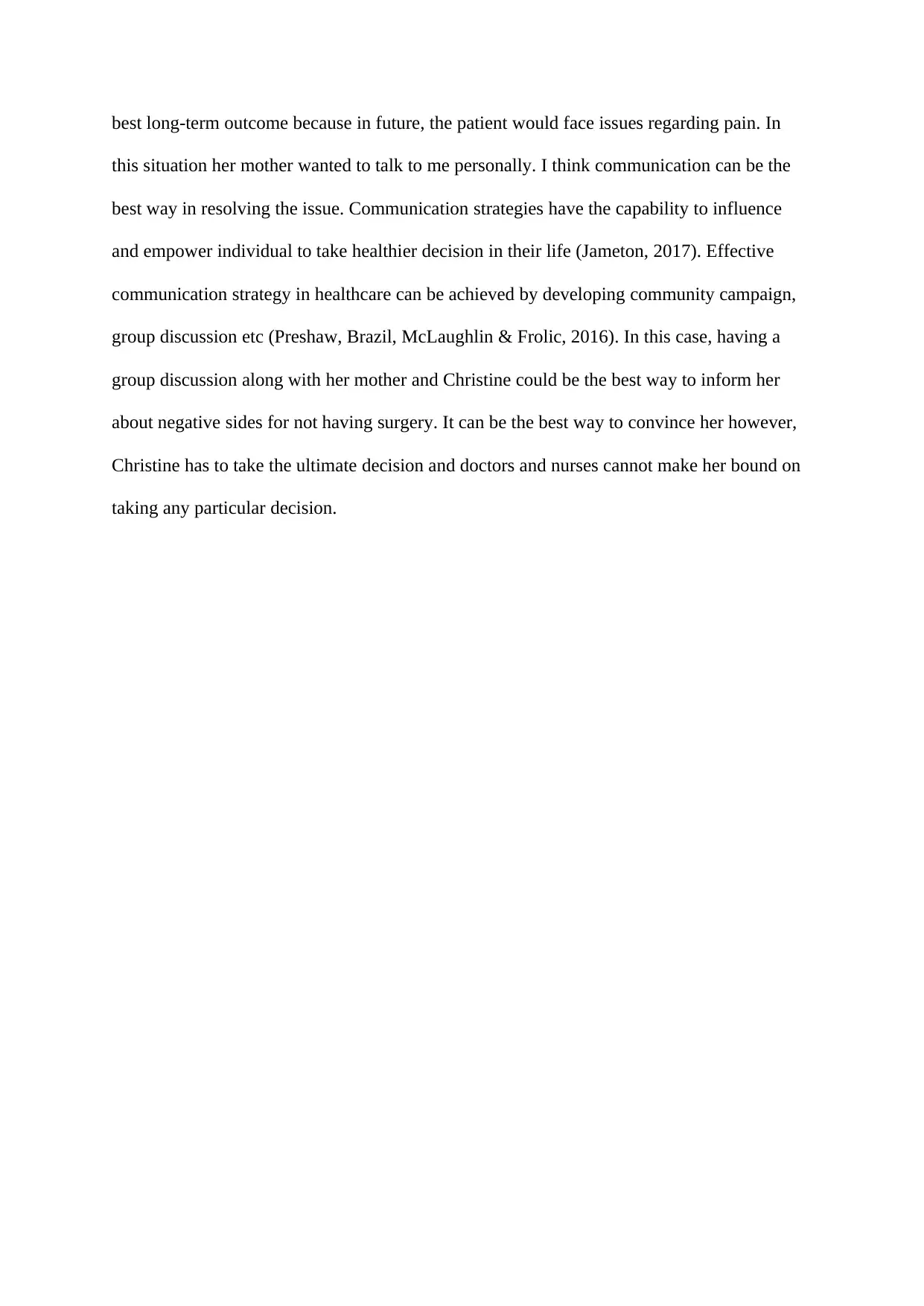
best long-term outcome because in future, the patient would face issues regarding pain. In
this situation her mother wanted to talk to me personally. I think communication can be the
best way in resolving the issue. Communication strategies have the capability to influence
and empower individual to take healthier decision in their life (Jameton, 2017). Effective
communication strategy in healthcare can be achieved by developing community campaign,
group discussion etc (Preshaw, Brazil, McLaughlin & Frolic, 2016). In this case, having a
group discussion along with her mother and Christine could be the best way to inform her
about negative sides for not having surgery. It can be the best way to convince her however,
Christine has to take the ultimate decision and doctors and nurses cannot make her bound on
taking any particular decision.
this situation her mother wanted to talk to me personally. I think communication can be the
best way in resolving the issue. Communication strategies have the capability to influence
and empower individual to take healthier decision in their life (Jameton, 2017). Effective
communication strategy in healthcare can be achieved by developing community campaign,
group discussion etc (Preshaw, Brazil, McLaughlin & Frolic, 2016). In this case, having a
group discussion along with her mother and Christine could be the best way to inform her
about negative sides for not having surgery. It can be the best way to convince her however,
Christine has to take the ultimate decision and doctors and nurses cannot make her bound on
taking any particular decision.
Paraphrase This Document
Need a fresh take? Get an instant paraphrase of this document with our AI Paraphraser
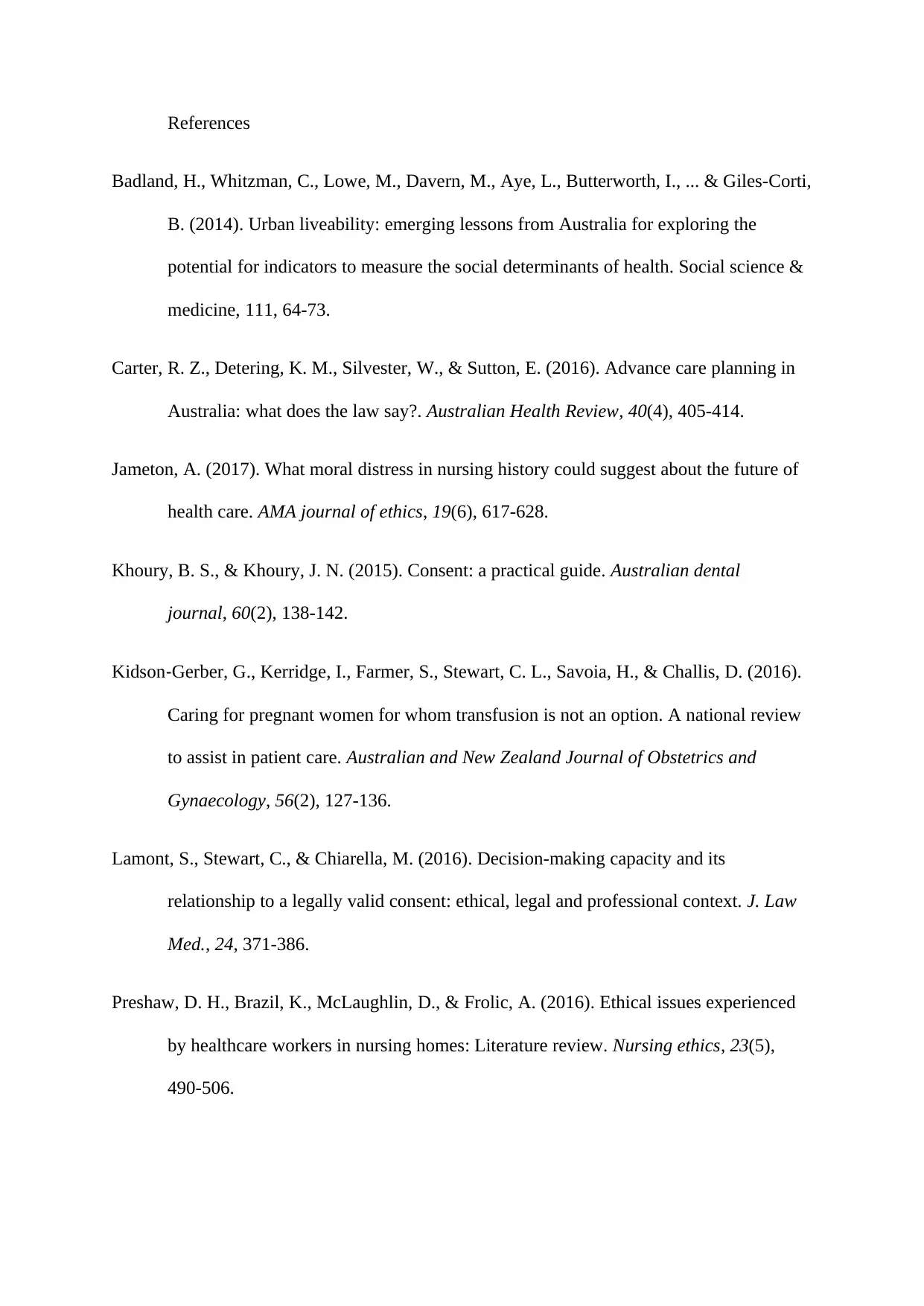
References
Badland, H., Whitzman, C., Lowe, M., Davern, M., Aye, L., Butterworth, I., ... & Giles-Corti,
B. (2014). Urban liveability: emerging lessons from Australia for exploring the
potential for indicators to measure the social determinants of health. Social science &
medicine, 111, 64-73.
Carter, R. Z., Detering, K. M., Silvester, W., & Sutton, E. (2016). Advance care planning in
Australia: what does the law say?. Australian Health Review, 40(4), 405-414.
Jameton, A. (2017). What moral distress in nursing history could suggest about the future of
health care. AMA journal of ethics, 19(6), 617-628.
Khoury, B. S., & Khoury, J. N. (2015). Consent: a practical guide. Australian dental
journal, 60(2), 138-142.
Kidson‐Gerber, G., Kerridge, I., Farmer, S., Stewart, C. L., Savoia, H., & Challis, D. (2016).
Caring for pregnant women for whom transfusion is not an option. A national review
to assist in patient care. Australian and New Zealand Journal of Obstetrics and
Gynaecology, 56(2), 127-136.
Lamont, S., Stewart, C., & Chiarella, M. (2016). Decision-making capacity and its
relationship to a legally valid consent: ethical, legal and professional context. J. Law
Med., 24, 371-386.
Preshaw, D. H., Brazil, K., McLaughlin, D., & Frolic, A. (2016). Ethical issues experienced
by healthcare workers in nursing homes: Literature review. Nursing ethics, 23(5),
490-506.
Badland, H., Whitzman, C., Lowe, M., Davern, M., Aye, L., Butterworth, I., ... & Giles-Corti,
B. (2014). Urban liveability: emerging lessons from Australia for exploring the
potential for indicators to measure the social determinants of health. Social science &
medicine, 111, 64-73.
Carter, R. Z., Detering, K. M., Silvester, W., & Sutton, E. (2016). Advance care planning in
Australia: what does the law say?. Australian Health Review, 40(4), 405-414.
Jameton, A. (2017). What moral distress in nursing history could suggest about the future of
health care. AMA journal of ethics, 19(6), 617-628.
Khoury, B. S., & Khoury, J. N. (2015). Consent: a practical guide. Australian dental
journal, 60(2), 138-142.
Kidson‐Gerber, G., Kerridge, I., Farmer, S., Stewart, C. L., Savoia, H., & Challis, D. (2016).
Caring for pregnant women for whom transfusion is not an option. A national review
to assist in patient care. Australian and New Zealand Journal of Obstetrics and
Gynaecology, 56(2), 127-136.
Lamont, S., Stewart, C., & Chiarella, M. (2016). Decision-making capacity and its
relationship to a legally valid consent: ethical, legal and professional context. J. Law
Med., 24, 371-386.
Preshaw, D. H., Brazil, K., McLaughlin, D., & Frolic, A. (2016). Ethical issues experienced
by healthcare workers in nursing homes: Literature review. Nursing ethics, 23(5),
490-506.

Wernham, A., & Teutsch, S. M. (2015). Health in all policies for big cities. Journal of Public
Health Management and Practice, 21(Suppl 1), S56.
Health Management and Practice, 21(Suppl 1), S56.
⊘ This is a preview!⊘
Do you want full access?
Subscribe today to unlock all pages.

Trusted by 1+ million students worldwide
1 out of 6
Related Documents
Your All-in-One AI-Powered Toolkit for Academic Success.
+13062052269
info@desklib.com
Available 24*7 on WhatsApp / Email
![[object Object]](/_next/static/media/star-bottom.7253800d.svg)
Unlock your academic potential
Copyright © 2020–2025 A2Z Services. All Rights Reserved. Developed and managed by ZUCOL.





